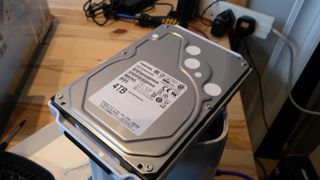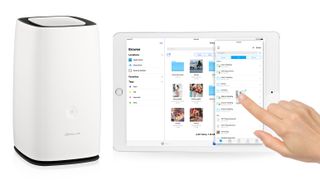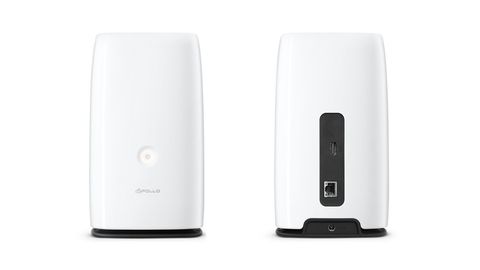Why you can trust TechRadar
Performance
As these devices go the performance of the Cloud 2 Duo is good, though not the best we’ve seen. On a PC using a mounted volume, CrystalDiskMark achieved read speeds of 107.6MB/s and wrote at 97.44MB/s. We suspect that it might go a little faster with proper NAS drives – like Seagate Iron Wolf or Western Digital Red – in there, but those numbers are more than acceptable.
Beyond those headline figures, there isn’t much else to say about the performance.

Mac-friendly
As we worked with the Apollo Duo, we realized how much of an Apple Mac-centric design it is, and how the PC part of this equation was most likely an afterthought.
A mild hint of this came when we connected it to our network, and it failed to appear as an icon as a computer, media device, or as part of the network infrastructure.
In short, there doesn’t appear to be a discoverable SMB service here, only an AFP Apple protocol.
You can mount a location on the Duo using a provided PC app, and sync a folder between the two, but this isn’t much like most DNLA-capable NAS boxes we’ve seen.
You can reference it with a name or IP number (as in: \\192.168.1.187), but you can’t define a workgroup or define any Domain/LDAP relationship.
Equally, the cloud functionality has been created to address a very narrow channel of uses.

What it can do on iOS and Android is secure photos, videos, music and other known documents, ignoring all the other cloud data that falls outside those basic definitions.
A selling point that Promise makes in its promotional material mentions how this device can automatically create Smart Albums based on using facial recognition tags that are applied by Apple and Google Cloud stored images. Unfortunately, this only works on Android in the US, as that functionality is disabled beyond those geographic borders.
Creating Smart Albums by location (GPS tag) works, but there is no way to create or change tags in the viewing application should you wish to more accurately place them.
Compared with the Cloud Sync functionality that Synology has in its NAS boxes this solution is remarkably limited. It doesn’t address the fact that many people use Dropbox, OneDrive, Amazon S3, Baidu Cloud, Box, Azure, HiDrive and a dozen other cloud services.
Sadly, cloud support isn’t the only feature that Promise tailored for very selective use.
The one (and only) USB port only works with NTFS, exFAT and HFS external storage devices. Amazingly FAT32 isn’t included, probably the most common format for memory cards and flash devices. And, on that subject, most NAS boxes support sharing printers on USB or connecting to a UPS, but neither of those is supported here.
There should have been two USB ports at least, and FAT32 (along with maybe ETX4 formatted) drives should have been accessible.
We could go on, but the list of declined opportunities and missing features is excessively lengthy.

Final verdict
Most of the issues with the Cloud 2 Duo revolve around finding the balance between ease of use and providing long-term useful functionality.
But perhaps the biggest stumbling block that this product faces is pricing. As we mentioned at the outset of this review, it will set you back around £499 ($449 in the US).
For less outlay Synology’s DS218j DiskStation and two 4TB NAS drives is an option, and it’s a solution that does significantly more than the Apollo Cloud 2 Duo. Equally, the Western Digital My Cloud Mirror is just £364 ($399 in the US) and offers a similar but more pliable platform.
If you’re an Apple fan and want something simple that you can use to secure cloud data from your iPhones and iPads, along with Time Machine on your Mac, then the Apollo Cloud 2 Duo is perfectly specified.
However, that statement does assume that you’ll never outgrow those initial requirements. In its present form, this isn’t a flexible system where the user can easily bolt on new functionality as their needs evolve.
For PC and Android users, there are cheaper options available that can do everything the Apollo NAS can do, and so much more. In those ecosystems, the Cloud 2 Duo looks heavy on cost and light on functionality.
- These are the best NAS devices of 2017
Mark is an expert on 3D printers, drones and phones. He also covers storage, including SSDs, NAS drives and portable hard drives. He started writing in 1986 and has contributed to MicroMart, PC Format, 3D World, among others.

This has to be the most absurd portable power station ever launched — Asus's Mjolnir throws the hammer at rivals with innovative design that's likely to divide opinions

Pixel's new satellite feature could show people where you are on Google Maps

I really hope Google doesn't promise 7 years of Android for the Pixel 8a

